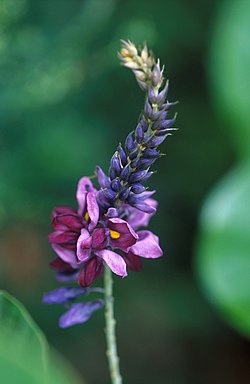
Back Fabaceae Afrikaans Fabaceae AN بقولية Arabic بقوليه ARZ Fabaceae AST Paxlakimilər Azerbaijani Ҡуҙаҡлылар ғаиләһе Bashkir Бабовыя Byelorussian Бабовыя BE-X-OLD Бобови Bulgarian
| Fabaceae | |
|---|---|
 Pueraria lobata (Kudzu) | |
| Sistematika | |
| Carstvo | Plantae |
| Divizija | Angiosperme |
| Red | Fabales |
| Porodica | Fabaceae Lindl.[2] (Leguminosae Jussieu, nom. cons.).[3] |
| Raznolikost | |
| 730 rodova i 19.400 vrsta | |
| Eudikotiledone | |
| Sinonimi | |
Fabaceae, Leguminosae ili Papilionaceae, odnosno mahunarke ili lepirnjače[4] obično poznate kao leguminoze, grašci ili porodica grahova – je velika i ekonomski značajna porodica cvjetnica. Obuhvata drveće, grmove i višegodišnje ili jednogodišnje zeljaste biljke, koje se lahko prepoznaju po mahunama i zaliscima lišća. Ova grupa je široko rasprostranjena, treća po veličini porodica kopnenih biljaka po broju vrsta, samo iza orhideja (Orchidaceae) i zvjezdarki (Asteraceae), sa 630 rodova i preko 18.860 vrsta.[5][6]

Pet najvećih od 630 rodova mahunarki su:
- Astragalus (preko 2.000 vrsta),
- Robinia bagremi (preko 1000 vrsta),
- Indigofera (oko 700 vrsta),
- Crotalaria (oko 700 vrsta) i
- Mimosa mimoze (oko 500 vrsta),
koji čine oko četvrtinu svih vrsta ove porodice. Poznato je oko 18.000 mahunarskih vrsta, što iznosi oko 7% svih vrsta cvjetajućih biljaka (cvjetnica). Vrste porodice Fabaceae se najčešće mogu naći u tropskim kišnim šumama i u suhim šumama Amerike i Afrike.[5][7][8]
Nedavni molekulski i morfološki dokazi idu u prilog tome da su Fabaceae jedan monofiletska porodica. Ovo gledište ne podržava samo stepen međusobne povezanosti koju pokazuju različite grupe unutar porodice u odnosu na one među mahunarkama i njihovim najbližim srodnicima, već i sve nedavne filogenetičke studije zasnovane na analizi sekvenci DNK.[9][10][11][12] Ova istraživanja potvrđuju da su Leguminosae monofiletna skupina koja je usko povezana s porodicama Polygalaceae, Surianaceae i Quillajaceae i da pripadaju redu Fabales.[13]
Uz žitarice, voće i tropsko korijenje, brojne mahunarke su osnova ljudske ishrane tokom mnogih milenija. Njihova upotreba usko je povezana sa evolucijom čovjeka. Mnoge od njih su važne poljoprivredne i prehrambene biljke, među kojima su: Glycine max (soja), Phaseolus (grah), Pisum sativum (grašak), Cicer arietinum (leblebija), Medicago sativa (lucerna), Arachis hypogaea (kikiriki), Lathyrus odoratus (slatki grašak), Ceratonia siliqua (rogač) i Glycyrrhiza glabra (sladić). Veliki broj vrsta su također ukrasne u različitim dijelovima svijeta, uključujući: Cytisus scoparius (metlika), Robinia pseudoacacia (bagrem), Ulex europaeus (evropska štipalica), Pueraria lobata (kudzu), kao i brojne vrste roda 'Lupinus (leće).
- ^ Wojciechowski, M. F.; Lavin, M.; Sanderson, M. J. (2004). "A phylogeny of legumes (Leguminosae) based on analysis of the plastid matK gene resolves many well-supported sub clades within the family". American Journal of Botany. 91 (11): 1846–62. doi:10.3732/ajb.91.11.1846. PMID 21652332.CS1 održavanje: više imena: authors list (link)
- ^ Angiosperm Phylogeny Group (2009). "An update of the Angiosperm Phylogeny Group classification for the orders and families of flowering plants: APG III" (PDF). Botanical Journal of the Linnean Society. 161 (2): 105–121. doi:10.1111/j.1095-8339.2009.00996.x. Pristupljeno 4. 2. 2014.
- ^ Watson L.; Dallwitz, M. J. (1. 6. 2007). "The families of flowering plants: Leguminosae". Arhivirano s originala, 8. 10. 2017. Pristupljeno 9. 2. 2008.
- ^ International Code of Nomenclature for algae, fungi, and plants. Arhivirano 27. 9. 2013. na Wayback Machine Article 18.5 states: "The following names, of long usage, are treated as validly published: ....Leguminosae (nom. alt.: Fabaceae; type: Faba Mill. [= Vicia L.]); Kada Papilionaceae odgovaraju različitoj porodici u značenju Leguminosae, ime Papilionaceae je konvertirano u Leguminosae.
- ^ a b Judd W. S., Campbell C. S., Kellogg E. A. Stevens P. F., Donoghue M. J. (2002): Plant systematics: a phylogenetic approach. Sinauer Axxoc, ISBN 0-87893-403-0.
- ^ Stevens, P. F. (2006). "Fabaceae". Angiosperm phylogeny website. Version 7. Referenca sadrži prazan nepoznati parametar:
|coauthor=(pomoć) - ^ Magallón, S. A., and Sanderson, M. J.; Sanderson (2001). "Absolute diversification rates in angiosperm clades" (PDF). Evolution. 55 (9): 1762–1780. doi:10.1111/j.0014-3820.2001.tb00826.x. PMID 11681732. Arhivirano s originala (PDF), 19. 10. 2013. Pristupljeno 8. 1. 2016.CS1 održavanje: više imena: authors list (link)
- ^ Burnham, R. J., & Johnson, K. R. 2004. South American palaeobotany and the origins of neotropical rain forests. Phil. Trans. Roy. Soc. London B, 359: 1595–1610.
- ^ Lewis G., Schrire B., Mackinder B. and Lock M. 2005. (eds.) Legumes of the world. The Royal Botanic Gardens, Kew, Reino Unido. 577 pages. 2005. ISBN 1-900347-80-6.
- ^ Doyle, J. J., J. A. Chappill, C.D. Bailey, & T. Kajita. 2000. Towards a comprehensive phylogeny of legumes: evidence from rbcL sequences and non-molecular data. pp. 1 -20 in Advances in legume systematics, part 9, (P. S. Herendeen and A. Bruneau, eds.). Royal Botanic Gardens, Kew, UK.
- ^ Kajita, T., H. Ohashi, Y. Tateishi, C. D. Bailey, and J. J. Doyle. 2001. rbcL and legume phylogeny, with particular reference to Phaseoleae, Millettieae, and allies. Systematic Botany 26: 515-536.
- ^ Wojciechowski, M. F., M. Lavin and M. J. Sanderson; Lavin; Sanderson (2004). "A phylogeny of legumes (Leguminosae) based on analysis of the plastid matK gene resolves many well-supported sub clades within the family". American Journal of Botany. 91 (11): 1846–1862. doi:10.3732/ajb.91.11.1846. PMID 21652332. Arhivirano s originala, 21. 6. 2010. Pristupljeno 8. 1. 2016.CS1 održavanje: više imena: authors list (link)
- ^ Angiosperm Phylogeny Group [APG] (2003). "An update of the Angiosperm Phylogeny Group classification for the orders and families of flowering plants: APG II" (PDF). Botanical Journal of the Linnean Society. 141: 399–436. doi:10.1046/j.1095-8339.2003.t01-1-00158.x. Arhivirano s originala (PDF), 10. 3. 2018. Pristupljeno 8. 1. 2016.